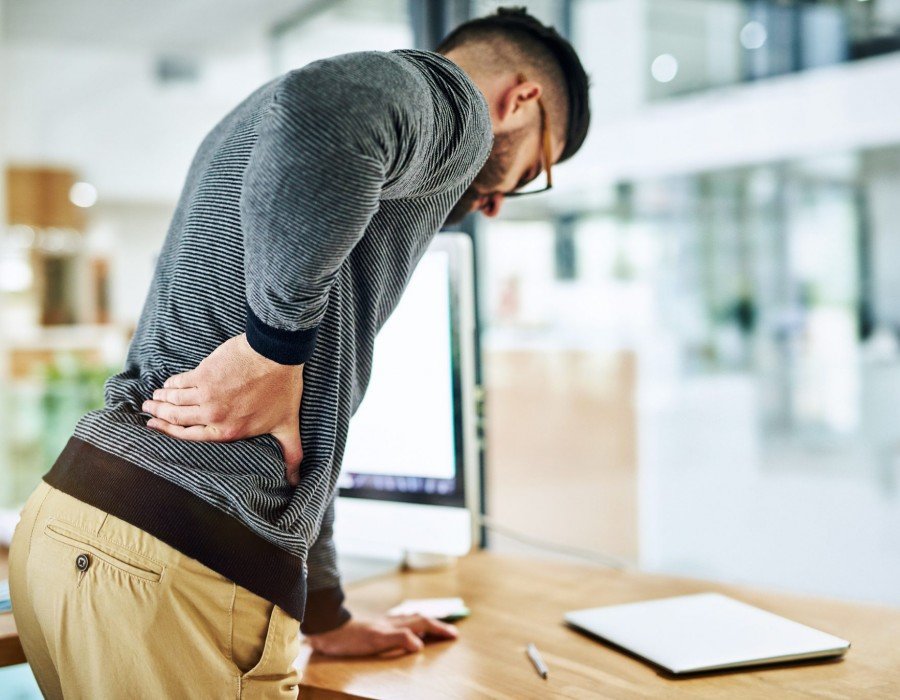Health and Wellbeing
Posture correcting exercises for Kyphosis

Postural curvature is a major cause of pain and tension in shoulders and upper back, but did you know that it can have repercussions on your overall health? Today we look at a specific type of postural curvature – kyphosis. As well as explaining what it is, we’ll share some top exercises on targeting and strengthening the muscles in our backs for better posture, reduced pain and a happier, healthier you.
What is kyphosis?
Look at a person from the side and you’ll see that the spine has a series of normal curves. Thoracic kyphosis – also known as Hyperkyphosis – is an exaggeration of the normal posterior curvature of the thoracic (upper-mid) spine. It causes the upper back to appear more rounded than usual, thus prompting the label ‘hunchback’.
A normal thoracic kyphotic curve measures between 20 and 40 degrees. It’s considered to be abnormal when greater than 40 degrees.
Kyphosis may occur at any age in males and females but it appears earlier in women.
Types and causes of kyphosis
The most common types and causes of kyphosis are:
- Postural Kyphosis: This is the most common type of kyphosis resulting from poor posture. In this mild form of kyphosis the muscles become weak and tight over time, causing abnormal spine curvature. It is most common in adolescents and young adults.
- Scheuermann’s Kyphosis: Also known as Scheuermann’s Disease, this is a defect of the vertebral body growth plate during adolescence. It results in an abnormal wedging of the vertebrae and, when left untreated, can get progressively worse. This type of kyphosis is more common in boys than girls.
- Congenital Kyphosis: This type of kyphosis is a developmental defect which occurs when the foetus is in the womb. The spinal column does not develop properly resulting in abnormal curvature of the spine.
- Neuromuscular Kyphosis: This is associated with other neuromuscular diseases such as cerebral palsy, spina bifida, polio and muscular dystrophy.
- Age-related Kyphosis: Degeneration in the spine as we grow older results in the loss of spinal disc height, affecting the spine’s normal curvature. Conditions like osteoporosis result in the weakness of bones and can also lead to kyphosis.
- Other causes: Trauma/vertebral fractures, spine infections, ankylosing spondylitis, spine tumors or dwarfism can all result in kyphosis.
Signs and Symptoms
Depending on the type and severity of kyphosis symptoms include:
- Appearance of a round back/hump
- Mild to severe pain in the back and shoulders
- Fatigue
- Reduced strength and mobility
- Stiffness and tenderness of the spine
In severe cases:
- Breathing difficulties, chest pain.
- Neurologic symptoms including loss of sensation, loss of bowel and bladder control
Treatment for abnormal Kyphosis
Treatment options depend on the cause, type and severity of kyphosis. Mild to moderate cases do not require surgical intervention; sufferers can be prescribed pain relievers and anti-inflammatories to help with their symptoms.
Symptoms associated with postural kyphosis do not worsen over time. Therefore, physiotherapy treatment including manual therapy, exercise therapy and taping is an effective, first-line approach.
In cases like Scheuermann’s disease exercises and bracing may be recommended to help prevent further progression of kyphosis. In severe cases, surgical intervention involving spinal fusion is required.
Exercises for management
Posture correction and muscle strengthening exercises are very effective for individuals with postural kyphosis. As well as targeting and correcting the kyphosis, these exercises may also be recommended for overall strength and flexibility. This is especially relevant in cases such as Scheuermann’s disease.
It is vital to stretch and strengthen the muscles of the cervical and thoracic spine (neck and upper back). It is equally important to work on your core, gluteal (buttock muscles) and hamstrings which are the key muscle groups involved in a kyphotic posture.
Five simple exercises…
Supine neck retraction
Lie on your back with your knees bent and feet flat on the floor. Pull your chin in so that the head is pushed back towards the floor. Hold this position for 10 seconds and then release. Repeat 10-15 times.
Scapular wall slides
Stand against the wall with your feet 18-20 inches away from the wall. Your upper back, shoulders and bum should be touching the wall. Raise your arms above your head then bend your elbows so that your upper arms are parallel to the floor and your forearms gently press against the wall. Inhale and slide your hands and arms up the wall, then slide back to the arms to your start position as you exhale. Remember to engage your core to prevent your lower back from arching.
Prone Cobra
Lie face down with your legs extended behind you and your arms by your sides, palm up. Lift your head and chest just off the floor. Now turn both your palms out and away from your body whilst keeping your thumbs up. Keep your chin tucked in and core engaged. Hold for 15-20 seconds then release. Repeat 6 times.
Superman
Lie down on your tummy and stretch both your arms in front. Lift your arms and legs off the floor, lengthening through fingers and toes. Keep your core and gluteal muscles engaged while performing the exercise. Repeat 10-15 times.
Resistance Rowing
Secure a resistance band to a door handle approximately at the height of your waist. Hold the ends of the band and take a step back, keeping your feet shoulder-width apart. Bend both elbows and squeeze your shoulder blades together to ‘row’ backwards. Slowly return to your starting position and repeat 10-15 times. Before performing the exercise routine, it is crucial that you consult your Physiotherapist and most importantly listen to your own body. Seek help if any exercise causes increased pain and discomfort.